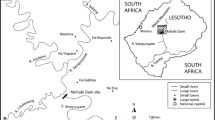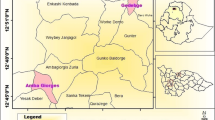Abstract
In Solan district, the developmental activities associated with chemical based farming, rapid urbanization, and rampant industrialization have led to many diarrhoeal, gastroenteritis, and hepatitis disease outbreaks. This has necessitated for microbiological assessment of indicator organisms, the thermotolerant coliforms, in drinking water sources, and their relationship with diarrhoeal disease. All the 49 Public Health Institutes (PHIs) of the district were categorized into very low, low, moderate, and high disease burden regions by stratification method. For drinking water, 55.5, 16.5, and 17% people preferred springs, borewells, and hand-pump respectively. These sources inventoried by Knowledge, Attitude, and Practice survey in one of very low and seven of high disease burden regions, and were analyzed by multiple tube fermentation technique. A cross-sectional survey of 200 children was undertaken for diarrhoeal disease estimation. Parwanoo, an industrial and Kurgal, a non industrial region witnessed highest (30.20) and lowest (4.40) Most Probable Number (MPN) per 100 ml water of thermotolerant coliforms, respectively. Thermotolerant coliforms were also observed significantly more (16.77 MPN/100 ml water) in monsoon than in post monsoon season (9.04 MPN per 100 ml water). The thermotolerant coliform Escherichia coli was recovered from six and three water sources respectively during monsoon and post monsoon. A strong correlation (r = 0.78) existed between the diarrhoeal disease occurrence and the concentration of thermotolerant coliforms in monsoon whereas it was moderate (r = 0.61) in post monsoon. The study indicated more contamination of water sources due to industrial activities which further got aggravated during the rainy season of the region.




Similar content being viewed by others
Data availability
Transparency of data is present in the study.
References
APHA- AWWA-WPCF. (2017). Standard methods for the examination of water and wastewater. (2-9, 2-48, 4-87, 4-134, 9-47), 23rd Edition. New York: APHA.
Bain, R., Cronk, R., Wright, J., Yang, H., Slaymakr, T., & Bartram, J. (2014). Fecal contamination of drinking- water in low- and middle- income countries: a systematic review and meta- analysis. PLoS Medicine, 11, e1001644, 10.1371/journal.pmed.1001644
Banoo, S., Kar, R. N., & Panda, C. R. (2013). Seasonal variation and distribution of sewage pollution indicator and human pathogenic bacteria along Odisha coast. Indian Journal of Geo- marine sciences, 43, 859–869 http://nopr.niscair.res.in/handle/123456789/28771.
Bhatti, R. (2016). Ground water year book Himachal Pradesh (2014-15). (pp.1-49). Dharamshala. http://www.cgwb.gov.in/Regions/GW-year-Books/GWYB-2014-15/GWYB%20NHR%202014-15.pdf. Accessed 24 July 2020.
Borade, S., Dhawde, R., Maloo, A., Syed, N., & Dastager, G. (2014). Occurrence and seasonal variation in distribution of fecal indicator bacteria in Tapi estuary along the West coast of India. Indian Journal of Geo- Marine Sciences, 43, 340–347 http://nopr.niscair.res.in/handle/123456789/27338.
Collins C. R., & Lynes, P. M. (1976). Microbiology method. 4th edition (pp 271-75). London: Butterworth Press.
Cosgrove, W. J., & Loucks, D. P. (2015). Water management: current and Future challenges and research directions. Water Resources Research, 51, 4823–4839. https://doi.org/10.1002/2014WR016869.
Edberg, S. C., Rice, E. W., Karlin, R. J., & Allen, M. J. (2000). Escherichia coli: the best biological drinking water indicator for public health protection. Journal of Applied Microbiology, 88, 106S–116S. https://doi.org/10.1111/j.1365-2672.2000.tbs05338.x.
Elmund, G. K., Allen, M. J., & Rice, E. W. (1999). Comparison of Escherichia coli, total coliform, and fecal coliform populations as indicators of wastewater treatment efficiency. Water Environment Research, 71(3), 332–339 http://www.jstor.org/stable/25045219.
Gomez, K. A., & Gomez, A. A. (1984). Statistical procedures for agricultural research with emphasis on rice. (p. 680p). New York: John Wiley and Sons.
Gould, L. H., Walsh, K. A., Vieira, A. R., Herman, K., Williams, I. T., Hall, A. J., et al. (2013). Surveillance for food borne disease outbreaks- United States, 1998- 2008. US department of Health and Human services, Centers for disease control and prevention. MMWR Surveillance Summary, 62(2), 1–34 http://www.pubmed.ncbi.nlm.nih.gov/23804024/.
Hong, H., Qiu, J., & Liang, Y. (2010). Environmental factors influencing the distribution of total and fecal coliform bacteria in six water storage reserviours in the Pearl river delta region, China. Journal of Environmental Sciences, 22, 663-668. 10.1016/s1001-0742(09)60160-1
Ibrahim, J. M., Sufiyan, M. B., Olorukooba, A. A., Gobir, A. A., Adam, H., & Amadu, L. (2017). Knowledge, attitudes, and practices of household water purification among caregivers of under-five children in biye community, Kaduna State. Archives of Medicine and Surgery, 1, 35-41. 10.4103/archms.archms_1_17
International Institute for Population Sciences-ICF. (2017). National Family Health Survey (NFHS-4), 2015-16: India. Mumbai. http://www.rchiips.org/nfhs/NFHS-4Reports/India.pdf. Accessed 5 March 2020.
Jain, S. K., Agarwal, P. K., & Singh, V. P. (2007). Hydrology and water resources of India (pp 7-13). Netherlands: Springer. 10.1007/1-4020-5180-8
Karnwal, A., Dohroo, A., & Mannan, M. A. (2017). Microbial analysis of potable water and its management through useful plant extracts. International Journal of Science and Research, 73, 44–49. https://doi.org/10.21506/j.ponte.2017.3.34.
Kishtwaria, J., & Gandotra, V. (2017). An assessment of quality of water and its impact on health in hilly region of district Kangra, Himachal Pradesh. Journal of Human Ecology, 8, 69–72. https://doi.org/10.1080/09709274.1997.11907237.
Lins, H. F. (2008). The imperative of water resources assessment. WMO Bulletin, 57(3), 159-162. http://www.public.wmo.int/en/bulletin/imperative-water-resources-assessment. Accessed 5 March 2020.
Liou, S.M., LO, S. L., & Wang, S. H. (2003). A genelralized water quality index for Taiwan. Environmental monitoring and assessment, 96, 35-52. 10.1023/B:EMAS.0000031715.83752.a1
Nikhil, S. G. (2015). Diarrheal epidemic grips Ghallour Sub-centre, Jwalamukhi Block, Kangra District, Himachal Pradesh, India. Family Medicine and Medical Science Research, 4, 157. https://doi.org/10.4172/2327-4972.1000157.
Pearce, N. (2012). Classification of epidemiological study designs. International Journal of Epidemiology, 41, 393–397. https://doi.org/10.1093/ije/dys049.
Sachs, J. D. (2012). From millennium developmental goals to sustainable developmental goals. Lancet, 379, 9832, P2206-2211. https://doi.org/10.1016/S0140-6736(12)60685-0.
Shiklomanov, I. A. (1998). World Water Resources-a summary of the monongraph prepared in the framework of International Hydrological Programme. (pp 1-37). Paris. United Nations Educational, Scientific and Cultural Organization. http://www.caee.utexas.edu/prof/mckinney/ce385d/Papers/Shiklomanov.pdf. Accessed 6 March 2020.
Shiklomanov, I. A. (2000). Appraisal and assessment of world water resources. Water International, 25(1), 11–32. https://doi.org/10.1080/02508060008686794.
Singh, R., & Sukhatme, B. V. (1969). Optimum stratification. Annals of the institute of Statistical Mathematics, 21, 515–528. https://doi.org/10.1007/BF02532275.
Singh, A. K., Chawla, S., Chawla, B., Bhaglani, D. K, & Sharma, K.C. (2017). Role of a surveillance system in the management of an outbreak of dengue in the mid hills of Himachal Pradesh, India. Journal of Clinical and Diagnostic Research, 11 (11):LC01-LC05. 10.7860/JCDR/2017/29655.10861
Singh, A. K., Bhardwaj, R. R., Bhaglani, D. K., & Chawla, S. (2018). Surveillance system eliciting an outbreak of gastroenteritis due to Bacillus cereus associated with consumption of contaminated food. International Journal of Recent Scientific Research, 9 (5B), 26594-26597. 10.24327/IJRSR
Singh, R. K., Sinha, V. S. P., Joshi, P. K., & Kumar M. (2019). Use of Savitzky-Golay filters to minimize multi-temporal data anamoly in land use land cover mapping. Indian Journal of Forestry, 42 (4), 362-368. https://www.researchgate.net/publication/342412928_Use_of_Savitzky_-Golay_Filters_to_Minimize_Multi-temporal_Data_Anomaly_in_Land_cover_mapping. Accessed 18 November 2020.
Singh, R. K., Sinha, V. S. P., Joshi, P. K., & Kumar, M. (2020a). Modelling Agriculture, Forestry and other land use (AFOLU) in response to climate change scernarios for the SAARC nations. Environmental Monitoring and Assessment, 192, 236. 10.1007/s10661-020-814-2
Singh, R. K., Sinha, V. S. P., Joshi, P. K., & Kumar, M. (2020b). A multinomial logistic model-based land use and land cove classification for the South Asian Association for Regional Cooperation Nations using Moderate Resolution Imaging Spectroradiometer product. Environment, Development and Sustainability. 10.1007/s10668-020-00864-1
Smith, R. S. (2018). Classification of water related disease. Water and Health. In Encyclopedia of Life Support Systems, 21-22.
UN DESA. (2016). The Millennium Development Goals Report 2015, UN, New York, 10.18356/6cd11401-en.
UNICEF. (2009). Water, sanitation and hygiene. Cluster coordination handbook. A practical guide for all those involved in the water, sanitation and hygiene cluster. 1st ed (pp 273-74). New York: Global WASH Cluster.
Vaithyanathan, L., & Ravichandran, S. (2015). Water contamination of suburban south India and its implication for enteric infection. Indian Journal of Science and Technology, 8(36). https://doi.org/10.17485/ijst/2015/v8i36/88613.
World Bank. (2011). The World Bank Annual Report 2011: year in review. Washington, DC. World Bank. https://openknowledge.worldbank.org/handle/10986/2378 License: CC BY 3.0 IGO. Accessed 22 January 2020.
World Health Organization. (2015). United Nations The Millennium Development Goals Report 2015. (pp 7-8). New York. http://www.un.org/millenniumgoals/2015_MDG_Report/pdf/MDG%2020215%20Summary%20web_english.pdf. Accessed 3 March 2020.
Yasin, M. M., AbuAmr, S. S., & Al-Nazar, H. M. (2006). Assessment of microbiological water quality and its relation to human health in Gaza Governorate, Gaza strip. Public Health, 120, 1177–1187. https://doi.org/10.1016/j-puhe.2006.07.026.
Author information
Authors and Affiliations
Corresponding author
Ethics declarations
Conflict of interest
The authors declare that they have no conflict of interest.
Ethical approval
The ethical approval of the study was sought from the YS Parmar University of Horticulture and Forestry, Nauni, Solan, Himachal Pradesh, India.
Consent to participate
Voluntary informed consent was sought from the study participants of the cross-sectional survey.
Consent for publication
Consent for publication is granted
Additional information
The research work got selected and was presented as a poster at Field Epidemiology Training Programs India Conference 2020 held at Chennai, India on 3–5 March 2020.
Publisher’s note
Springer Nature remains neutral with regard to jurisdictional claims in published maps and institutional affiliations.
Rights and permissions
About this article
Cite this article
Singh, A.K., Bhardwaj, S.K. & Devi, S. Microbiological status of drinking water sources and its relationship with human health in Solan, India. Environ Monit Assess 193, 32 (2021). https://doi.org/10.1007/s10661-020-08833-x
Received:
Accepted:
Published:
DOI: https://doi.org/10.1007/s10661-020-08833-x




